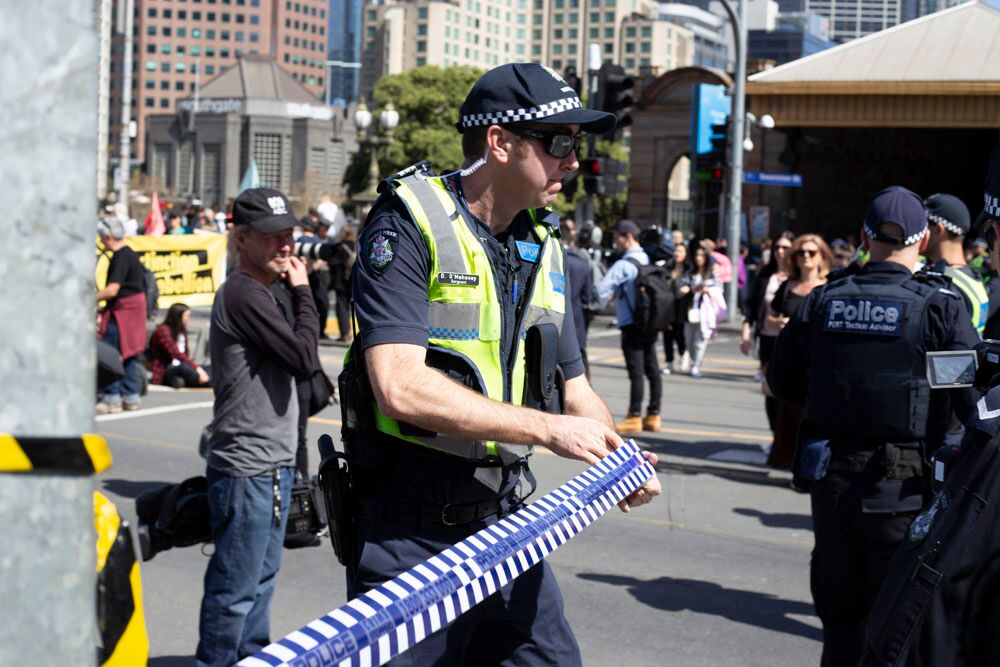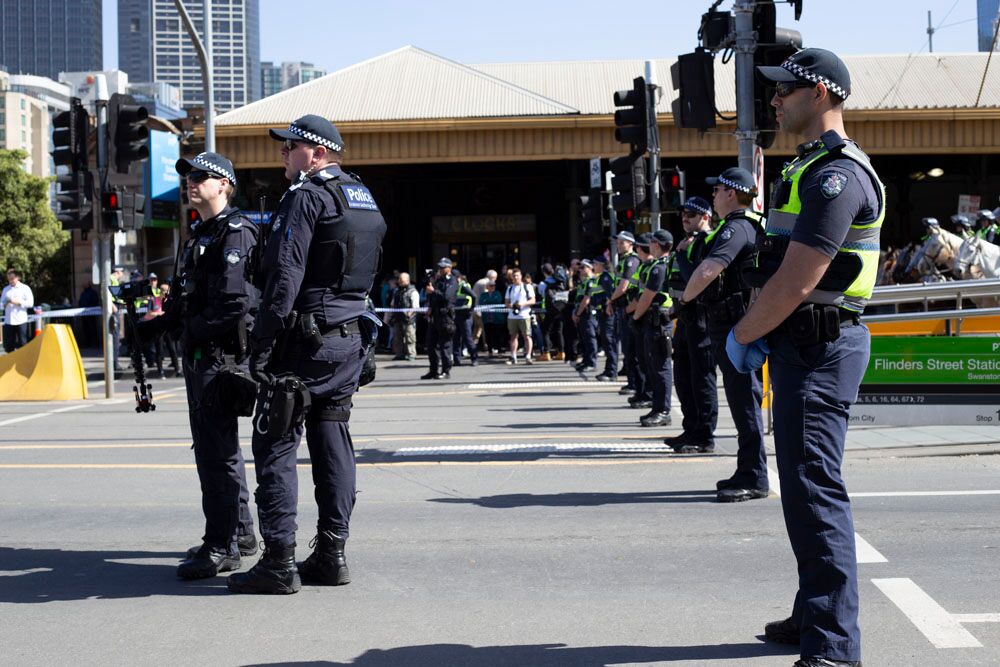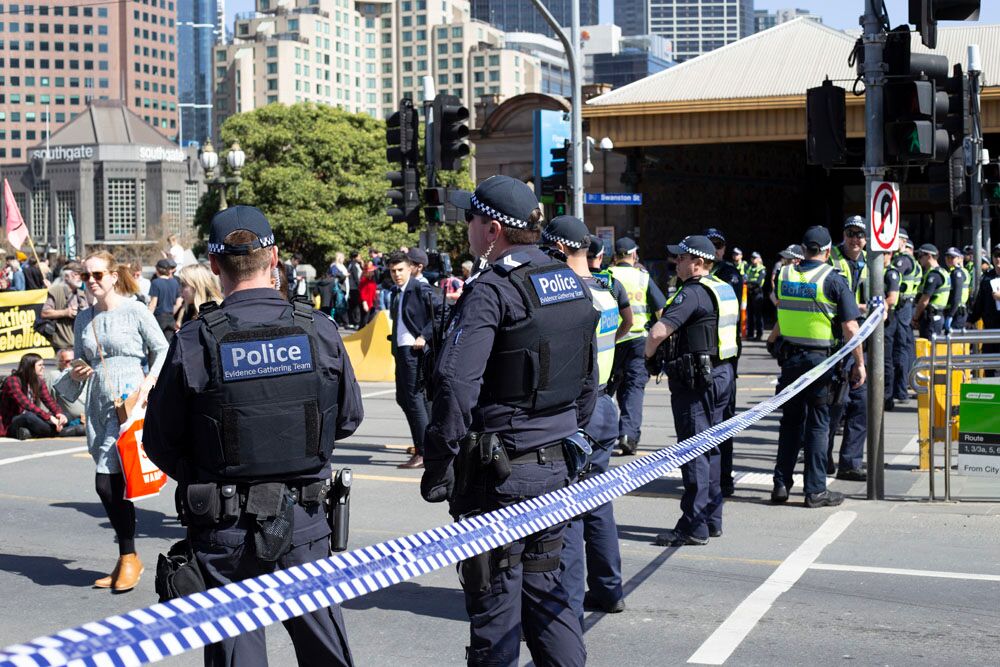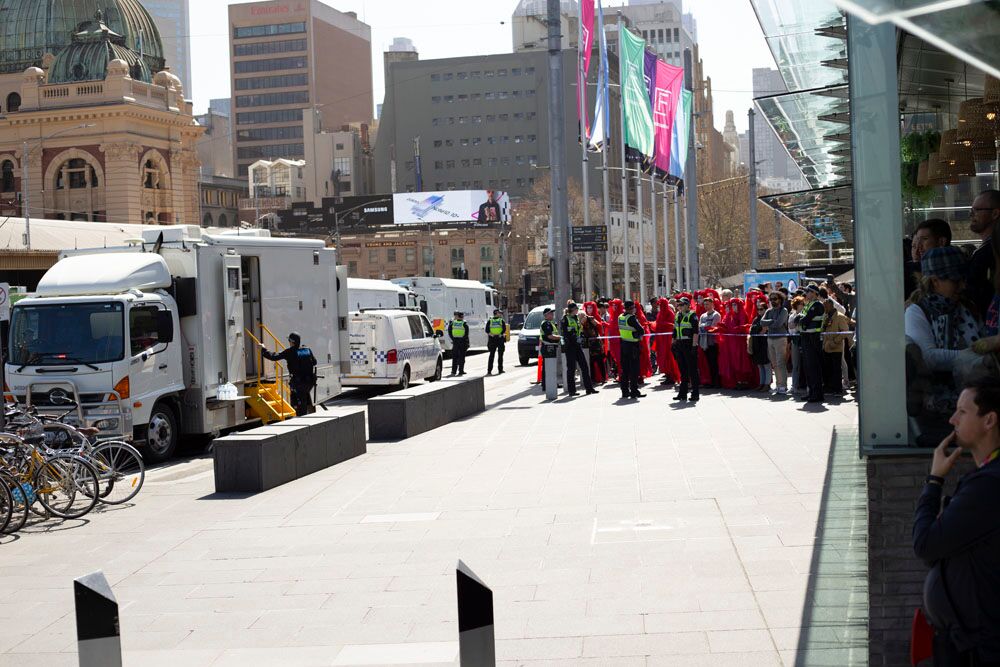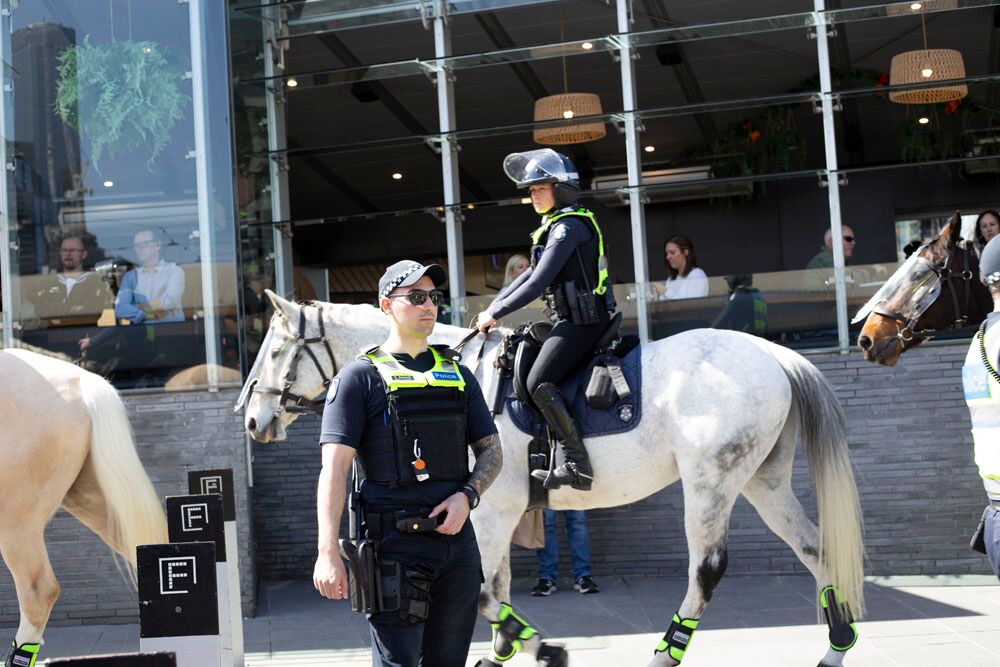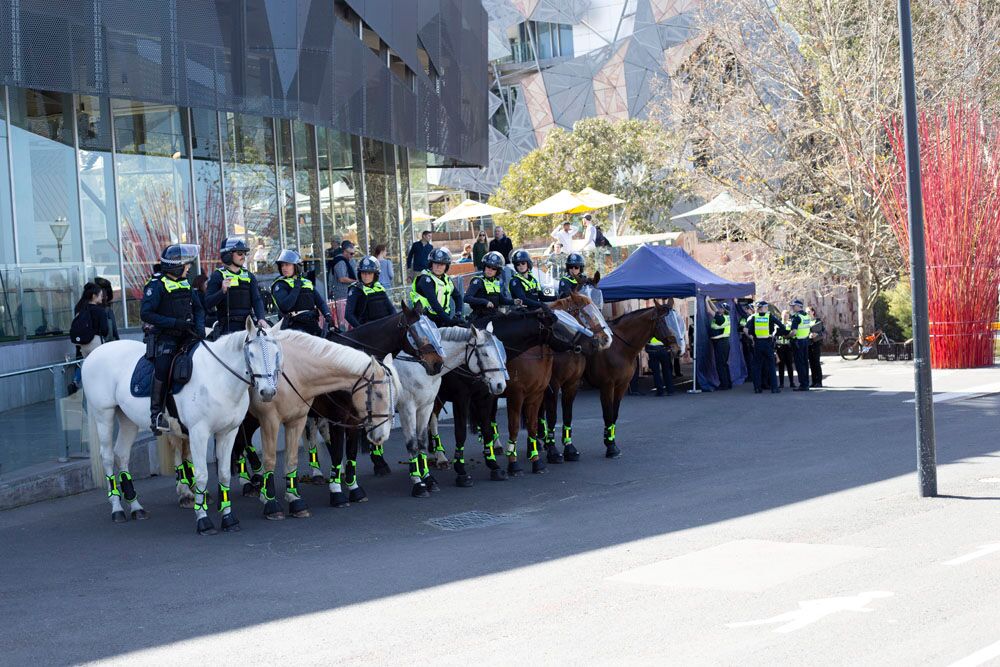Statement of Concern: The Policing of ‘Extinction Rebellion’
Princess Bridge Blockade and dance protest event Saturday 14th September 2019, Melbourne, Australia
Please Note: A response by Victoria Police to the Statement of Concern is included below.
On Saturday 14th September 2019 Melbourne Activist Legal Support (MALS) fielded a team of eight (8) trained Legal Observers at the ‘Princes Bridge Block & Dance’ protest event that took place on St Kilda Road between the Flinders Street intersection and the Victorian Arts Centre precinct.
The protest was organised by sixteen local chapters of an international climate movement, Extinction Rebellion. The widely promoted event was billed as an explicitly nonviolent “powerful, fun and peaceful disruption.”1 The protest was originally intended to go until 21:00 that evening.2
Legal Observers worked in pairs and were interspersed across the protest site from 11:30 until 15:00, monitoring and recording observed police manoeuvres, conduct and interactions with protesters. The team observed several hundred police working in different Public Order Response Team (PORT) units, arrest teams, the Mounted Branch, plain clothes police prosecutors, the Evidence Gathering Team and witnessed up to forty-four (44) arrests by police.
Over that time the legal observers team noted several areas of concern as described below. Six recommendations to Victoria Police stemming from these observations are included at the end.
A downloadable copy of this Statement is available here (PDF).
1. The police cordon prevented hundreds of supporters from joining the protest thereby limiting the right to peaceful assembly.
From approximately 12:15 police began placing blue and white police tape across the road at the both the north (CBD) end and the south (Arts Centre) end of the protest area. This tape, combined with lines of police along and around the area affectively created a ‘protest zone’ on the Princess Bridge. Police started soon after (from 12:27 onwards) police began preventing people entering or moving through this area including the footpaths on either side of the bridge. By 12:30 the area including footpaths was entirely blocked by police cordons. People were directed to use other bridges to get to the opposite side of the Yarra River.
Importantly, this cordon was established and people actively prevented from accessing the protest prior to any warning of unlawful activity being provided by police.
Reasons provided to Legal Observers and the public by individual police members as to why they were preventing access varied but many cited ‘public safety’ or ‘operational safety’ whilst numerous police members failed to provide any reason for restricting people’s right to attend the protest event. By 13:00 several hundred people were surrounding the police cordon area at different points with many verbally expressing a desire to join the protest [see Figure 6]. Some protesters who had left the areas to use nearby facilities were not permitted back to the assembled protest. Legal observers witnessed several people attempting to enter or remonstrating with police to be able to enter and join the protest assembled on the bridge. Numerous people also expressed concern on social media (Facebook / Twitter) about not being able to join the protest as they had intended to do.
The right to peaceful assembly is protected at international law. In Victoria, the Charter of Human Rights and Responsibilities Act 2006 (Vic) ss15 and 16;3 expressly protects and promotes the rights to Section 16 – Peaceful assembly and freedom of association assembly and expression. Police cannot place restrictions to arbitrarily and discriminatorily intervene in protest.4
According to the Victoria Police Manual (VPM):
All police actions that limit another person’s human rights must be:
– lawful
– necessary, reasonable and proportionate, and
– in compliance with the Charter of Human Rights and Responsibilities Act 2006.
Where applied, any time, place or manner restrictions on protest must be in good faith, in accordance with law, and conform to the principle of necessary and proportionate limitation.
‘Breach of the Peace” powers, often cited by police in these circumstances to move on members of the public, require imminent threat of violence or property damage to come into effect and are far too ill-defined to provide justification for a limitation such as this.
The United Nations Special Rapporteur on the rights to freedom of peaceful assembly and of association has stated that government action restricting protest need to be specific; they cannot be made in the abstract “or by indicating general, unspecified risks, but must be made in an individualized fashion, applied in the particular case or with a specific justification.”5
Melbourne Activist Legal Supports asserts that the police cordon established by Victoria Police around this protest from 12:15 until 15:00, unjustifiably limited people’s right to assemble together peacefully in order to protest. We contend that this limitation on the right to peaceful assembly was without lawful basis or rationale on the grounds of safety or public order. Despite a degree of ‘disruption’ caused by the protest event, this disruption was time limited and no more significant in affect than other large rallies and assemblies held regularly in the Melbourne CBD. There was no threat to public safety present or expressed.
It is the view of MALS that the police cordon was solely an operational tactic by police that allowed them to control the protest, limit its scale and therefore to more easily facilitate the affecting of arrests. This operational reason does not form a reasonable justification for the limitation of such an important right under Section 7 of the Victorian Charter.6
2. Media representatives, journalists and camera operators were directed by police to leave the cordon ‘protest area’ from 13:00. This restriction on media ability to film, interview and cover the protest event was without a clear lawful basis.
Legal observers first noted police directing media to leave at 13.04 when Channel Nine news crew was directed to leave. Other journalists and camera operators were directed to move to the other side of the police tape or cordon systematically over the next 15 minutes.
Police members provided various reasons when questioned by media personnel about why they were being directed to leave, citing ‘safety’ ‘operational safety’ or ‘police operations’. Legal Observers did not record any police providing a lawful reason or citing a legislative power for this action. Police have limited powers to move-on or direct a person to leave an area, particularly a protest or picket. It is not clear whether police were exercising powers under Section 6(1) of the Summary Offences Act 1966 or seeking to apply common law ‘breach of the peace’ powers. In either case is doubtful whether the criteria for the use of such powers would have been met in these circumstances.7
It is an important principle that journalists should be allowed to carry out their duties reporting on a matter of public interest. Although safety was the most cited reason provided by police, media are well versed in covering arrest situations from a distance that does not hinder or endanger police or protesters. The restriction applied at this protest prevented interviews, footage and coverage of the protest being obtained and appeared to be without a clear lawful basis.
3. Obstruction of Legal Observers

Although police permitted some Legal Observers to remain within the cordoned ‘protest area’, at 12:47 several legal observers were directed by police to leave the cordoned area. Importantly, this direction severely limited the ability of legal observers to monitor arrest procedures and the use of force when carrying out an arrest. From the distance legal observers were not able to ascertain whether levels of force consistent with guidelines and lawful powers were being used.
Under the United Nations Declaration of Human Rights Defenders, Legal Observers have a right to fulfill their role unhindered and without obstruction.8
4. Use of Mounted Branch at a peaceful protest
The Victoria Police mounted branch, (police horses) were present at this protest event, forming lines of police horse around the main protest group at the north and south end of the police cordon.
As we have stated previously the deployment of police horses for such public protest events is unwarranted an unnecessarily intimidating.
The legal observer team could see no operational reason for the Mounted Branch being deployed given the number of police present, the nature of the protest and presence of elderly, disabled and very young people. Any use of horses in public environments and amidst large crowds is by its nature extremely hazardous, due to the risk of uncontrolled and potentially fatal use of force. We reiterate our assertion that police horses should be prohibited from deployment in all crowd control applications.
5. Use of handcuffs and zip-ties when carrying out arrests
Legal observers noted multiple uses of metal handcuffs and plastic zip-ties being used as constraints during several arrests. Handcuffs were not used on all persons arrested.
The use of handcuffs or similar restraints on a non-compliant person is considered a Use of Force and should only be used under particular conditions. In this circumstance there were no threats that warranted restraints being used.

Handcuffs can cause ligament, arm or shoulder injuries, circulatory problems and severe bruising, particularly when people are being carried or moved by police. One person arrested at this protest reported cuts on arms received during their arrest. Anther protester reported that he was told by police that he was “resisting arrest” when he was only trying to stand up from a sitting position. Numerous people reported that they considered the use of restraints entirely unnecessary, as they had no intention of resisting the arrest process.
By taking a person into custody, police impact a person’s rights and freedoms under the Charter of Human Rights and Responsibilities Act 2006.
“Any use of force must be justified and only to the level required to reasonably effect arrest or removal of persons.”
Victoria Police Manual, Crowd Control
In the circumstances observed at this protest event we do not consider the use of handcuffs and zip ties to be justified. We assert that hand cuffs or zip ties should not be used for non-resisting arrestees and not be used in circumstance where people are being carried or moved after choosing not to cooperate with their arrest.
6. The carrying of long side handled batons and capsicum (OC) spray
Legal Observers noted multiple police members carrying long side-handled batons and holstered capsicum (OC) spray canisters at this protest event. Legal Observers noted one police member carrying OC spray in an unclipped holster.
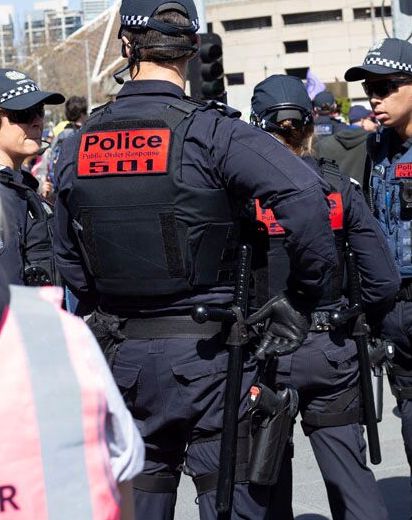
As required by VPMP Operational safety and equipment, the Police Forward Commander must give careful consideration to the type of operational safety or other protective equipment that will be carried or worn by members at planned public order operations. “The level of equipment carried or worn should be commensurate to the risk likely to be encountered.”
The Legal Observer team asserts that the carrying of long batons and OC spray at this protest event was unwarranted given the risks likely to be encountered. The open deployment of police weaponry is always intimidating and can be perceived as threatening to the public. This threat and intimidation can be, in affect, a limitation upon the rights of peaceful assembly and association if people do not fee safe to come to or remain at a protest.
Other Observations
The Legal Observer team noted several warnings being provided by police by megaphone at different times and in different locations and that police provided an individual warning and an opportunity for people to leave the area prior to each arrest.
Legal Observers also noted that arrest teams of six or more police members were used to affect each arrest. This provided enough members to carry those people who chose not to cooperate with the arrest procedure and ‘go limp’ relatively safely. Aside from those issues referred to above this meant that people were not dragged or put in danger of injury by being carried by inadequate numbers of police.
Recommendations
- Victoria Police consult with bodies such as the Victorian Equal Opportunity and Human Rights Commission (VEOHRC) to review its VPMP Police attendance at events and incidents, operational planning and operation orders in relation to all large civil disobedience protest events in order to ensure that the right to peaceful assembly and association is fully respected and not limited by police cordons and operational tactics that contain or restrict access to protests areas;
- Victoria Police specifically note the role of civilian Legal and Human Rights Observers within its Crowd Control VPMG and for Forward Commanders to brief operational members of the requirement to ensure the safety and access of Legal Observers who may be present at subsequent protest events;
- Victoria Police specifically note the role of media representatives and camera operators within its Crowd Control VPMG and for Forward Commanders to brief operational members of the requirement to ensure the safety and access of media who may be present at subsequent protest events;
- The Victoria Police update the Use of Force and the Operational Safety and Tactics Training (OSTT) VPMG and associated OST training to specifically prohibit the use of handcuffs or other restraints in protest situations when a person is ‘passively resisting’ or ‘going limp’ and ensure that they not used in circumstances where the person is being carried;
- Victoria Police ensure that Operation Orders contain risk assessments that acknowledge and incorporate the risk of limiting Victorian Charter rights through the open and visible deployment of police weaponry, police horses and intrusive surveillance by drone or Evidence Gathering Teams.
Policy Rules contained in the Victorian Police Manual (VPM) cited above are mandatory and provide the minimum standards that employees must apply. Non-compliance with or a departure from a Policy Rule may be subject to management or disciplinary action.
This Statement of Concern is a public document and is provided to media, Victoria Police Professional Standards Command (PSC), Independent Broad-based Anti-corruption Commission (IBAC), the Victorian Equal Opportunity and Human Rights Commission (VEOHRC), Government ministers, Members of Parliament and other agencies upon request.
A downloadable copy of this Statement is available here (PDF).
For inquiries regarding this statement please contact us.
Response by Victoria Police to Statement of Concern
Received 3rd October 2019
Victoria Police functions include: preserving the peace, protecting life and property, preventing the commission of offences, detecting and apprehending offenders and helping those in need of assistance. These functions reflect the long standing role of police in our community in protecting the human rights of all people and to only limit the rights of individual people by the least restrictive means reasonably necessary in the delivery of policing services to the whole community.
The Victorian Charter of Human Rights outlines the human rights and responsibilities possessed of every person in Victoria. These include, within the context of public protest and demonstrations, the right to:
- Recognition and equality before the law (and particularly to be treated with fairness and respect and in a non-discriminatory way)
- Freedom of movement
- Freedom of expression, unless this expression harms the rights and reputations of other people
- Peaceful assembly and freedom of association
- Be protected from having property taken, unless the law says it can be taken.
The Charter also makes it clear in its preamble that “human rights come with responsibilities and must be exercised in a way that respects the human rights of others”. This principle applies equally to police in the exercise of their discretion, as much as it does to any person who may conduct themselves in a way which might affect the human rights of other people.
Victoria Police plays an important role in balancing the rights of all people in the Victorian community, and ensuring the safety and public utility of all public spaces including the Melbourne CBD.
The Melbourne CBD is the location of many protests, demonstrations and public assemblies throughout any given year, and Victoria Police recognises the importance of facilitating peaceful protests and gatherings as an important part of the democratic fabric that holds our community together.
In the context of public protest, Victoria Police officers are required to balance the rights of people to go about their lawful business without being adversely impacted by the unlawful conduct of other people. This ultimately reflects what it means to live in community.
As the Assistant Commissioner North West Metropolitan Region, I am responsible for balancing the rights of individuals to peacefully gather and protest in the Melbourne CBD alongside the rights of all other people in the CBD to go about their lawful business unhindered by the activity of others.
An important element of getting this balance right is ensuring all Victoria Police members understand their legal obligations to protect and promote the human rights of all people as protected in the Charter. I am taking this opportunity to outline how Victoria Police does this, partially in response to some public comments made by individuals who were part of a recent protest in the Melbourne CBD criticising the actions of Victoria Police, to explain to them and to the broader community why we work in the manner that we do.
It is important to recognise that all people have the right to peacefully assemble and protest under the Charter, but these rights are not unlimited and come with responsibilities too on the part of protestors. Also, my members in North West Metro have to lawfully limit the human rights of people in their roles at times, and I fully support them to do this.
Both International Human Rights Law and Victorian Law protects the right to peaceful protest, and Victoria Police recognises that this includes some protest forms that inconvenience the public utility that would otherwise be enjoyed by other people in the community. The protest on September 14 is no exception to this, and Victoria Police allowed individuals to protest on the Princes Bridge in a manner that impeded traffic, trams and pedestrians in order that protestors could convey their political messages in a peaceful way.
On September 14, my operational commanders in charge of policing this protest, having identified risks:
- public safety
- of breaches of the peace
- the commission of other offences, and
- the rights of other citizens not involved in the protest being unlawfully infringed.
They then made a lawful decision to limit the rights of protestors by dispersing protestors after the protest had been underway for some time. The commentators who have criticised this decision of police note that they had intended that the protest ‘go on until 21:00 that evening’. The operational decision of Victoria Police was that this would disproportionately impact the rights of others and the movement of traffic through the Melbourne CBD, and consequently did not allow this to occur.
To be clear, the policing tactics and response on 14 September 2019 were undertaken to achieve the following ends:
- to protect public safety (the safety of people not involved in the protest, as well as those who were participating in the protest)
- to prevent possible breaches of the peace and the commission of other offences, and
- to ensure the rights of people not involved in the protest were not unlawfully infringed.
All Victorians can expect that Victoria Police will continue to apply this approach in its policing of future planned and unplanned demonstrations in the Melbourne CBD and I would hope that any human rights lawyers and human rights monitors operating in this space would likewise have regard for the rights of all people and consider that with rights come responsibilities.
I fully support my staff in their decisions in this protest, and in the exemplary work they do in policing the many protests that occur throughout the Melbourne CBD.
Assistant Commissioner Luke Cornelius APM, Northwest Metropolitan Region, Victoria Police
3/10/2019

